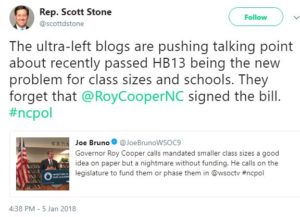Really Bad Legislation
The 2016 unfunded class-size reduction mandate is just one example of legislators’ strangely punitive relationship to district superintendents and public-school administrators throughout North Carolina. No matter what, the requirements that stem from this legislation would be mind-bogglingly expensive to enact. Yet somehow, state legislators are blaming local districts for not planning carefully enough, or for misallocating funds that could miraculously have built the required schools, installed the required trailers, and hired the required teachers in record time.
Multiple lawmakers have admitted that the legislation entailed some unintended consequences and was rushed through as part of a budget package, which limited opportunities for debate. Senate Pro Tempore Phil Berger was quoted in the Asheville Citizen-Times defending the law. Berger states that the 2016 “state budget included a class size reduction along with new funding to hire close to 450 additional first-grade teachers across the state,” but this defense does not address the following important issues:
- Additional Kindergarten, second-, and third-grade teachers will also be required.
- Wake County alone will require 460 new K-3 teachers in order to comply with the mandate, yet, as Berger admitted, the state only supplied enough funding for 450 first-grade teachers statewide.
- All of these new teachers will need classroom space.
Why would the NC General Assembly only pay for teachers’ salaries when clearly, additional classroom spaces will also be required? NC is ranked 43rd in the nation in per-pupil funding. The schools are not flush with cash.
Wake County has already budgeted (and issued bonds for) $2.191B in new-school construction, including 11 new elementary schools, equipment, and renovations through 2024. The 18 total new schools in the plan are required in order to deal with anticipated population growth. Has anyone calculated the cost of scrapping this plan and instead scrambling to fund the estimated 559 new classrooms that Wake County would need to build in order to comply with this absurd new class-size law?
Some state legislators don’t seem very concerned about this issue. In a letter to parents of students at a local public elementary school and published by NC Policy Watch, Representative Scott D. Stone, of District 105 (in Charlotte) shifts the blame for the lack of funding to Charlotte-Mecklenburg Schools, claiming that they misspent funds that the NCGA intended for hiring new teachers. But he never attempts to explain where CMS was expected to find the funding required to provide classrooms for all of those new teachers.
Astoundingly, he suggests that CMS could deploy some “creative” solutions, as had been tried in the past when, for example, one teacher “had to move from class to class.” And he then admits that this remedy was “not ideal,” but “a temporary situation.” It’s unclear from his letter how a temporary fix is helpful in the least bit for remedying the massive problems that the K-3 class-size reduction mandate will create. The legislation itself does not include an expiration date.
If CMS had hired a huge crop of new teachers without having physical classroom space to accommodate them, people would rightly have accused the district of mismanaging money. Yet Stone tries to blame CMS and their apparent misuse of NCGA funds for the anger expressed by these parents, to whose emails he is responding.
Perhaps even more astoundingly, Stone states his opinion that a large-scale purchase and installation of trailers on school property would be an acceptable solution to the classroom space issue. In a section of his letter in which he acknowledges some “challenges” associated with the legislation, he writes, “Even for schools which can accommodate the costs of mobile classrooms, the lead times to purchase these may lead to not having [sic] in place by August start dates.”
In all seriousness, should any NC student have to learn in a mobile classroom? Classrooms in trailers are an admission of defeat. They say to students, “Your education is not the top priority of the adults who run this state.” One estimate is that CMS will require more than 200 additional mobile classrooms to comply with this law.
Kris Nordstrom has also published a point-by-point rebuttal of Rep. Stone’s patronizing, evasive, and misleading letter. Nordstrom claims that statewide, “to be able to meet the FY 2018-19 class size requirement, districts still need nearly 4,750 additional teachers, at a cost of about $300 million.” And he doesn’t address the issue of how much time it will take to recruit and hire these teachers.
Stone mainly seems to be beating on the “blame the Liberals” drum. He has tweeted that “The ultra-left blogs” and Roy Cooper are complaining about HB13, the attempt to restore some sanity to the class-size mandate, and that they themselves (that is, Democrats) had been the ones to advocate for and sign HB13. As actually passed, HB13 only delayed the class-size requirements that had passed as part of the 2016 state budget. Lacking any viable alternative at the time, Gov. Cooper did sign it. But the link that Stone includes in his own tweet belies his point that HB13 itself is the real enemy, and that Gov. Cooper supported it:

A tweet like this one feeds into a larger pattern that pits Conservative legislators against teachers and against any school district in a large city; presumably, NC residents in cities tend to vote for Democrats, and so do teachers. However, our state legislature must represent all citizens, not just the ones who voted for individual lawmakers.
One can only hope that Rep. Stone’s attitude and ignorance of the issues are unique within the NC General Assembly.
A larger issue that is perhaps almost as disturbing as Rep. Stone’s evasiveness and ignorance is that in most of the rather copious debate about the class-size-reduction legislation, no one seems to state the obvious point: that the whole concept of reducing K-3 class sizes so drastically and rapidly is just a really bad idea. The justification for these reductions is minimal, and the many downsides are glaringly obvious. Even the conservative John Locke Foundation concurs: “Studies of class sizes in North Carolina public schools suggest there is little or no significant relationship between class sizes and student achievement. One research study also found that teachers’ perceptions about their class sizes were not tied to teacher job retention.”
The reductions in class sizes will be bad for schools, bad for districts, and bad for students. Taxpayers will not be willing to provide enough money to do a decent job of implementing these minuscule, wasteful classes. Ever.
Schools will instead be overcrowded; art, music, and PE classes will all have to be cut; and the sizes of classes in other grades will swell hugely.
Perhaps the legislature is just attempting to send massive waves of students into the waiting arms of private schools and charters?
See also: http://wakeednews.com/2017/12/28/class-size-reduction-sounds-like-a-waste/

